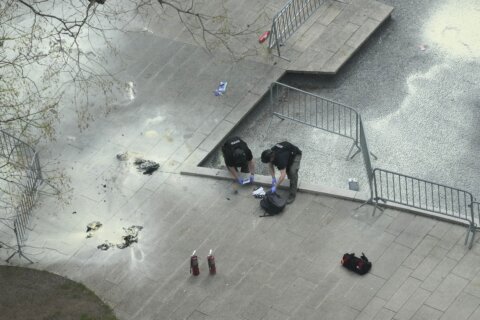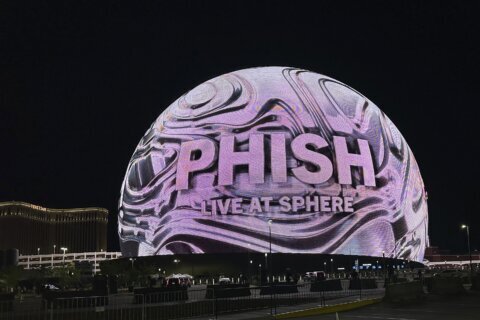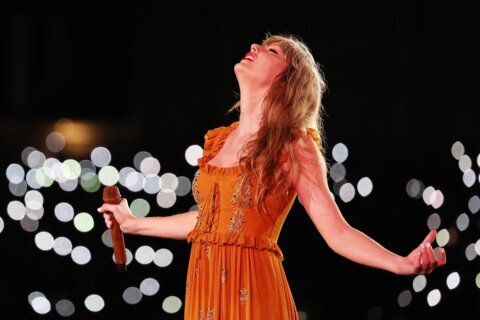Denzel Washington. Frances McDormand. Joel Coen. William Shakespeare.
I could probably stop my review right there and you’d already want to see the movie with a two-time Oscar winner working with the defending Best Actress champ, who reunites with her prolific director husband to adapt a timeless tale by the greatest playwright in history.
However, “The Tragedy of Macbeth” exceeds even the highest of expectations with a combustible cauldron of powerhouse performances, macabre visuals and symbolic direction that ranks among Coen’s finest work in his first foray without brother Ethan.
In case it’s been a while since you read the play in school, the story follows Scottish lord Macbeth, who is convinced by a trio of witches that he will soon become the next King of Scotland, aided by his ambitious wife, Lady Macbeth, who strategizes their power grab.
The cast is masterful from top to bottom as Cory Hawkins (“In the Heights”) elevates his career as the heroic avenger Macduff, Alex Hassell is a dead ringer for Jude Law as the dutiful messenger Ross, and Kathryn Hunter steals the show contorting her body as the trio of witches, who appear in a multiplicity of forms with scratchy-throated clairvoyance.
Still, the juiciest role is Lady Macbeth, whose shadow precedes her down the castle stairs as she sleepwalks toward insanity, rubbing her hands together in a famous line of regret: “Out, damned spot!” Her staff overhears this murder confession before she quietly returns upstairs with the chillingly fatalistic line: “What’s done can not be undone. To bed.”
Her fate is sealed, just like Macbeth. We haven’t wanted Denzel to meet his fate this much since “Training Day” (2001). The G.O.A.T. is in elite form, moving in and out of hallway shadows as he approaches King Duncan’s bedroom (“Is this a dagger in my hand?”) before ultimately staring down a climatic staircase to mourn, “Out, out brief candle.”
The rest of his monologue need not apply: “a tale told by an idiot, full of sound and fury, signifying nothing.” Coen is no idiot behind the camera, carefully constructed his shots with nightmarish sound and fury so that every image signifies something. Rarely do films from the 21st century achieve this level of symbolic mise-en-scene dripping from every frame.
The opening shot of three crows flying signifies the arrival of the three witches. Hunter appears as three surreal reflections in a pool of water, then three tangible figures on land walking away (one flinching slightly). As they disappear into the fog to Carter Burwell’s eerie score, Coen hatches a jump-scare of crows flocking directly toward the camera.
The black-and-white 1.37:1 aspect ratio adds to a claustrophobic atmosphere where even the opening title card is boxed so that the words have to be hyphenated to jump down to the next line. The equally confined set design harks back to Laurence Olivier’s “Hamlet” (1948) with sparse castle walls, clean lines, arched windows and diagonal staircases.
The set design and camera angles coalesce as Denzel gazes up at moonroof cross beams where the witches dangle (“Something wicked this way comes”). Suddenly, the castle floor transforms into water as Hunter becomes a child’s face reflected in liquid cupped inside Denzel’s hands. The water recedes after her “double, double toil and trouble” warning.
As the Macbeths hatch their murder scheme, they symbolically speak with faces in shadows, symbolizing their divided nature between good and evil, tempted by the latter. The lighting by cinematographer Bruno Delbonnel (“Inside Llewyn Davis”) rivals the best of 1920s German Expressionism, which of course inspired 1940s American film noir.
We see it most as Lady Macbeth trudges down a long corridor, moving in and out of shadows in a technique seen in classic noir like Billy Wilder’s “Double Indemnity” (1944) and Orson Welles’ “Touch of Evil” (1958), but also neo-noir like Jeffrey Beaumont moving in and out of shadows down suburban sidewalks in David Lynch’s “Blue Velvet” (1986).
Drops of Duncan’s blood hitting the ground reverberate with epic sound design. Turns out, it’s Macduff knocking at the castle door, a brilliant way to connect the sinful murder to the eventual comeuppance, foreshadowing that Macduff will be the one to kill Macbeth. When the two first meet, notice how Denzel stands in shadows while Hawkins appears in light.
There’s plenty to chew on, even what’s left unsaid off screen. Allow me to postulate:
As the Macbeths hold hands in an extreme wideshot, a long dissolve shows Ross “between them” in a hood. Most interpretations believe Lady Macbeth commits suicide by throwing herself down the stairs, but is Coen sneakily suggesting that Ross pushes her? After all, Ross is the last person seen walking up to Lady Macbeth on the staircase.
Either way, there’s no ambiguity to the finale as Macduff’s army storms the castle holding branches over their heads in disguise (“I think the grove moves”). As Denzel opens the window, leaves swirl inside to signal change, culminating with Macbeth and Macduff in a final sword fight along a narrow corridor atop the castle roof surrounded by a foggy mist.
At last, Coen has one final trick up his sleeve, a cinematic cherry on top of his delectable dessert, by symbolically showing Macbeth’s crown knocked off of his head. Greedily bending over to pick up his coveted crown becomes his deadly mistake, exposing his body for a fatal blow that sends the symbolic crown flying off the roof in slow motion into the fog.
Ladies and gentlemen, this is how you symbolically direct a movie! Something symbolic this way comes. Even if you struggle with Shakespeare’s Old English vernacular, the visual language by Coen is the stuff that cinema dreams — and nightmares — are made of.









